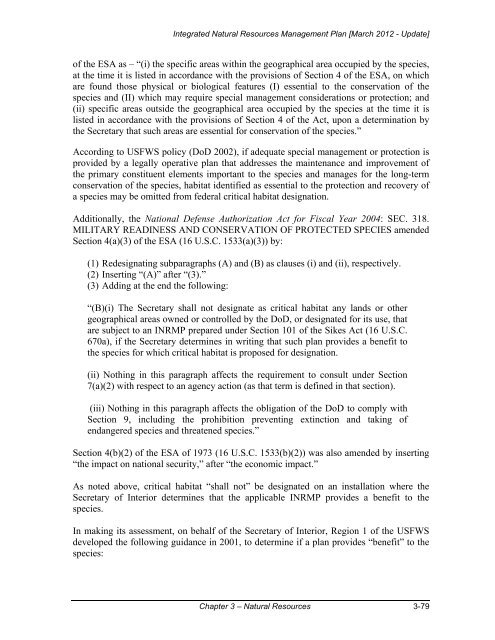Chapter 3 - Natural Resources - Marine Corps Base Camp Pendleton
Chapter 3 - Natural Resources - Marine Corps Base Camp Pendleton
Chapter 3 - Natural Resources - Marine Corps Base Camp Pendleton
You also want an ePaper? Increase the reach of your titles
YUMPU automatically turns print PDFs into web optimized ePapers that Google loves.
Integrated <strong>Natural</strong> <strong>Resources</strong> Management Plan [March 2012 - Update]<br />
of the ESA as – “(i) the specific areas within the geographical area occupied by the species,<br />
at the time it is listed in accordance with the provisions of Section 4 of the ESA, on which<br />
are found those physical or biological features (I) essential to the conservation of the<br />
species and (II) which may require special management considerations or protection; and<br />
(ii) specific areas outside the geographical area occupied by the species at the time it is<br />
listed in accordance with the provisions of Section 4 of the Act, upon a determination by<br />
the Secretary that such areas are essential for conservation of the species.”<br />
According to USFWS policy (DoD 2002), if adequate special management or protection is<br />
provided by a legally operative plan that addresses the maintenance and improvement of<br />
the primary constituent elements important to the species and manages for the long-term<br />
conservation of the species, habitat identified as essential to the protection and recovery of<br />
a species may be omitted from federal critical habitat designation.<br />
Additionally, the National Defense Authorization Act for Fiscal Year 2004: SEC. 318.<br />
MILITARY READINESS AND CONSERVATION OF PROTECTED SPECIES amended<br />
Section 4(a)(3) of the ESA (16 U.S.C. 1533(a)(3)) by:<br />
(1) Redesignating subparagraphs (A) and (B) as clauses (i) and (ii), respectively.<br />
(2) Inserting “(A)” after “(3).”<br />
(3) Adding at the end the following:<br />
“(B)(i) The Secretary shall not designate as critical habitat any lands or other<br />
geographical areas owned or controlled by the DoD, or designated for its use, that<br />
are subject to an INRMP prepared under Section 101 of the Sikes Act (16 U.S.C.<br />
670a), if the Secretary determines in writing that such plan provides a benefit to<br />
the species for which critical habitat is proposed for designation.<br />
(ii) Nothing in this paragraph affects the requirement to consult under Section<br />
7(a)(2) with respect to an agency action (as that term is defined in that section).<br />
(iii) Nothing in this paragraph affects the obligation of the DoD to comply with<br />
Section 9, including the prohibition preventing extinction and taking of<br />
endangered species and threatened species.”<br />
Section 4(b)(2) of the ESA of 1973 (16 U.S.C. 1533(b)(2)) was also amended by inserting<br />
“the impact on national security,” after “the economic impact.”<br />
As noted above, critical habitat “shall not” be designated on an installation where the<br />
Secretary of Interior determines that the applicable INRMP provides a benefit to the<br />
species.<br />
In making its assessment, on behalf of the Secretary of Interior, Region 1 of the USFWS<br />
developed the following guidance in 2001, to determine if a plan provides “benefit” to the<br />
species:<br />
<strong>Chapter</strong> 3 – <strong>Natural</strong> <strong>Resources</strong> 3-79

















